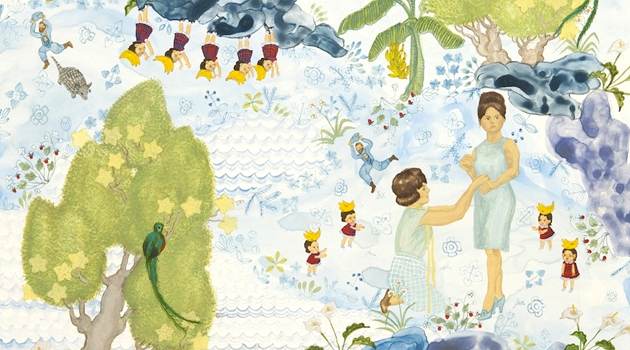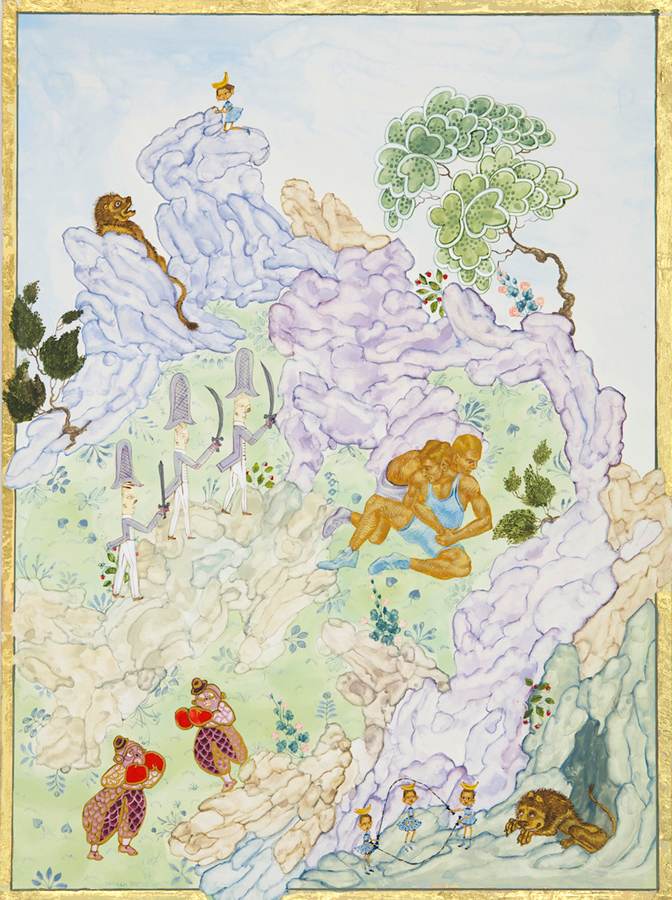Chiquita Banana
Paintings crammed with matriarchs, wrestlers, and girls wearing bananas on their heads—where quite a lot more is going on than first appears.

Interview by Karolle Rabarison
Painter Larissa Bates wrestles with a lineage—her family was involved with United Fruit, the U.S. company known for exploiting Costa Rica’s land and workers—that’s colored by both greed and charity. Her work reconciles the gentle with the forceful, the exotic with the familiar. Family history, the paintings suggest, is never simple. Read the interview ↓
Larissa Bates’s “Chiquita Banana” is on view at Monya Rowe Gallery in New York City, through June 16, 2012. All images courtesy of Monya Rowe Gallery, New York, all rights reserved.









Artist interview
TMN: Describe how this series came about. Did you work on multiple paintings at once?
Larissa Bates: This series is in some ways a continuation of the work I have been doing since 2003. Over time, various characters have developed and been added. The characters and scenery tend to relate to whatever I have been reading and thinking about. Grace Paley is always a favorite, as are Joan Didion and Alice Munro. I listened to Gil Fronsdal’s discussions of grief while painting several of these images. They are also heavily influenced by the art I have been seeing. I love Persian miniatures and have been looking at the Neue Gallery lately. I recently moved an entire shelf of art books right next to the desk where I paint, and now a quick swivel to the right helps to inspire stuck moments.
I do work on multiple paintings at the same time. For the past few years my paintings have been smaller, and so I usually have a few going at once. They progress together and sometimes end up completed within a couple of days of each other, and it is wonderful.
TMN: From what I’ve seen, male characters dominate your previous work. What prompted you to include female characters this go around?
Larissa Bates: I didn’t paint any female characters for a long time. For one, there is so much art history and cultural history around the female form. I wasn’t totally sure how to approach the female body without sexualizing it in some way, which wasn’t really what I was looking to do with my paintings. At the same time, I was fascinated by the kinds of social pressures we put on men in mainstream culture, and the male body became an interesting way to explore this.
Last year I had a baby girl, and it made me step back and spend a lot of time thinking about the complexities of mother-daughter relationships. My own mother passed away when I was an infant, and so I have a relatively idealized imagination of what maternal relationships can be. Having a daughter has opened my world up to an entire female/mother culture that was never part of my life before. I love sitting around, just kvetching with all of the other moms. It is such a novelty to me after having so many of my close relationships be with men—best friend, husband, brothers, and father.
Also, artists whose work expands ways of thinking about gender have been important in opening up the way I myself think about gender. Nicole Eisenman is particularly influential, as is Wu Tsang.
TMN: Do your family members connect with these images? Have the paintings changed your relationship with them?
Larissa Bates: So far they seem to be fine with them, but not everyone has seen them. I was fairly concerned about hurting people with this series. At the same time, I felt it was work I needed to make. Most of my Costa Rican family will not make it up to the show.
My little brother is in college and interviewed me about being an artist for a class assignment earlier this year. I was so nervous about what he was going to write. It was helpful to experience being the subject of another family member’s art and did make me very queasy. A few years ago I did a painting of my father as a centaur giving birth, and I think I understand how he may have felt.
TMN: Have you been to Costa Rica?
Larissa Bates: My mother was from Escazú, a suburb near the capital. I was born in Vermont, but we lived in Costa Rica and Vermont evenly split until I started grade school. My father was a stonemason and a painter, and he was building a house out of stone in the side of a mountain in Vermont. Back in the 1970s and 80s, a group of friends who were architects and artists moved to this mountain in Vermont and built a lot of experimental homes. We lived in an Airstream trailer in Vermont for half of the year while he worked on the house, and when it got cold we moved down to the farm in Vara Blanca, a small farming community near Poás Volcano. These days we mostly go down to visit family and for weddings.
TMN: You’re interested in social psychology. How do you explore that interest outside your art?
Larissa Bates: Mostly by listening to lectures while painting. Tal Ben-Shahar, Dan Seligman, and Sue Johnson have all revolutionized the way I think about relationships. It’s been enlightening to hear the extent to which we are completely social animals.
TMN: Would you rather be a turtle or a squirrel?
Larissa Bates: Turtle. The other day I looked out the window of my studio to see a squirrel napping on the roof. I took a video and sent it to my friend. What was so remarkable was that the squirrel was totally relaxed, just lounging there. I didn’t know squirrels knew how to relax! Apparently there is hope for the high-strung among us after all.
